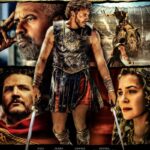
Civil War
In a New York running out of water and where war has arrived in the form of terrorism, with kamikaze attacks, the journalist Joel and the photographer Lee have decided that there is only one story left to tell: interviewing the President of the United States, who has long been entrenched in Washington while a ferocious Civil War spreads. Thus they set off on a journey to the capital, joined by the elderly and limping journalist Sammy and the young photographer Jessie, who sees in Lee a model to follow. The joint Western troops of Texas and California are moving against what remains of the government, but the region that the journalists will cross on their journey is not made up of pitched battles between sides and is instead prey to a chaos of micro-conflicts and atrocities.
The most provocative film of the year, and the most expensive ever produced by A24, does not offer explanations but rather shocks by unfolding a very violent conflict, set in America but aimed more generally at the degradation of Democracy.
Director Alex Garland has in fact declared that if in the United States certain things are exacerbated, for example by the omnipresence of firearms, there are civil wars that have been fought with machetes and have still caused tens of thousands of deaths. Garland says he could have set the film just as well in his native England or in any other democracy, because the true origin of this Civil War is the demonization of the political opponent, the assumption of both sides of a position of presumed ethical superiority which disqualifies the opposing party and prevents any confrontation, ever widening the divisions.
This is also why its protagonists have the only clear and constructive point of view: neutrality. Impartial to the extreme, they rebel against the state of things by documenting it without discount, even in the most grim horrors. Adrenaline junkies or emotionally anesthetized by the brutality they have witnessed, they cross an insidious and at times surreal America, where quiet villages are protected by snipers on the roofs and where soldiers dig mass graves.
Garland begins the film in medias res, without explanatory signs or summary dialogues for the benefit of the spectators: it is clear to the protagonists which parts are in play and that is enough for them. This radical refusal of didacticism translates into an extraordinary density: events follow one another rapidly, numerous and increasingly violent, up to a final assault on Washington as frightening as it is tense and effective from a spectacular point of view. The crescendo of death and destruction appears inevitable and will find a dry and bitter conclusion, anything but reassuring.








